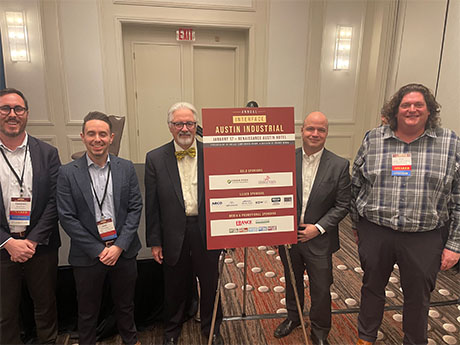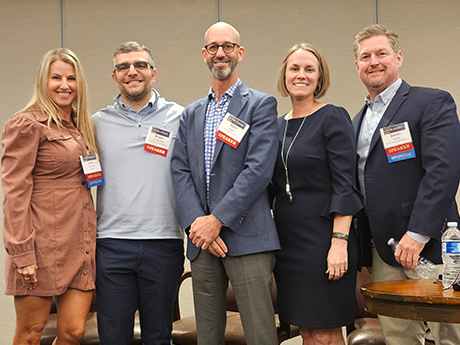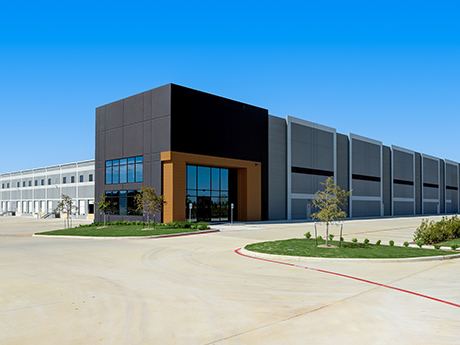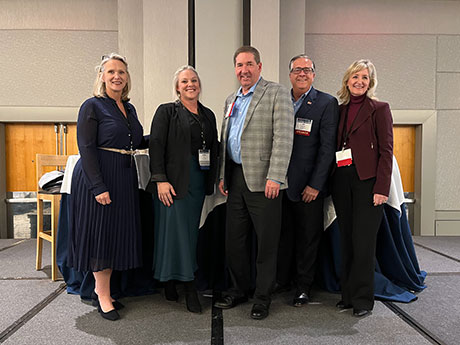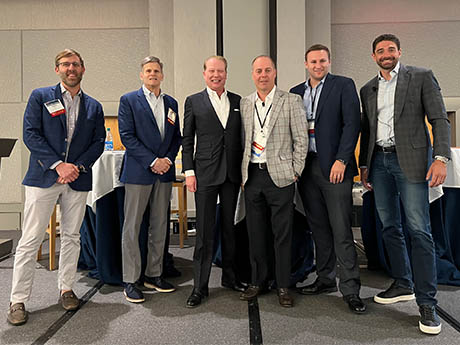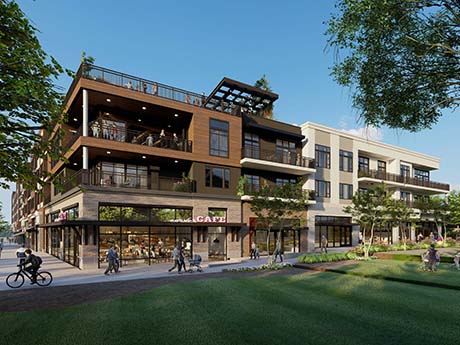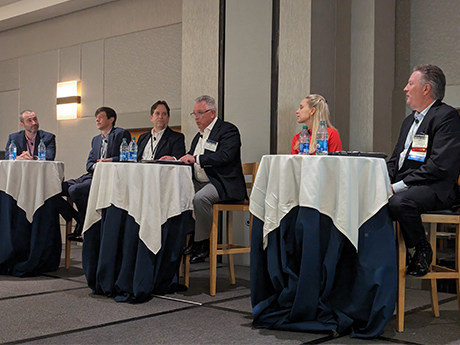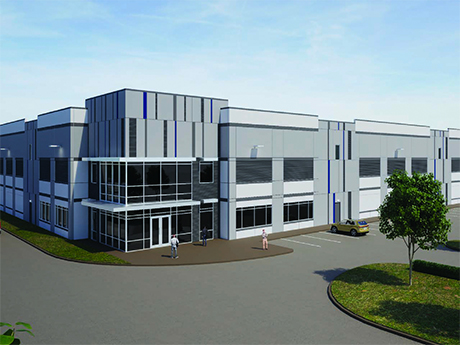By Taylor Williams When it comes to industrial supply growth in Central Texas, the usual suspects — land availability, interest rate movement, time-consuming permitting and approval processes — are all secondary to the need for more infrastructural development to support these projects. Roadways, public transit systems, electrical capacity, sewerage and water services — these are the key ingredients in the recipe for successful industrial development in Central Texas that can sometimes be overlooked or understated in importance. As such, economic development corporations (EDCs) in the area are prioritizing infrastructure development in their work as they help developers add much-needed industrial space to support the area’s burgeoning population. While underlying, efficient infrastructure is critical to all real estate developments and human occupation, it is especially crucial to industrial projects. Large-scale manufacturing facilities — think Tesla in East Austin and Samsung in its northern suburb of Taylor — employ thousands of people. Housing hasn’t caught up to population growth in many of the surrounding communities, necessitating alternate means of commuting. In addition, manufacturing and e-commerce facilities tend to have above-average electrical capacity requirements. Financially, meeting that demand might be made somewhat easier in a state that has a deregulated power grid, but logistically, …
Conference Coverage
Seniors Housing Investors Are Ready to Switch to Acquisitions Mode, Say InterFace Panelists
by Jeff Shaw
LOS ANGELES — In 2023, particularly in the second half of the year, a combination of forces slowed property sales to a crawl in the seniors housing sector. Amy Sitzman, executive managing director of seniors housing and care at Blueprint Healthcare Real Estate Advisors, laid out the laundry list of challenges. “The bid-ask spread conversation really has everything to do with what’s gone on in the market the past year and a half,” she said. “It has been trying for everybody dealing with interest rate hikes, inflation, operations, staffing challenges, expenses going out of control, the minimal lack of stabilized assets out on the market. We’re just trying to get our head around the value of assets today.” Sitzman made her comments as moderator of a panel titled “Investment Outlook: When Will the Bid-Ask Gap Narrow and Transactions Resume in Earnest?” at France Media’s InterFace Seniors Housing West conference, held Feb. 1 at the Omni Los Angeles. Speakers at the session included Michelle Kelly, senior vice president of investments, NHI; Darrin Smith, executive vice president of Investments, Sabra Health Care REIT; Bryan Schachter, chief investment officer, Watermark Retirement Communities; and Clint Malin, co-president and chief investment officer, LTC Properties. While …
InterFace Panel: Macroeconomic, Institutional Market Obstacles Hinder Retail Supply Growth in Austin
By Taylor Williams The Austin retail market is in dire need of more quality space, but between the newfound volatility in the U.S. capital markets and longstanding local policies that have hamstrung commercial developers in the state capital, delivering that space is no easy feat. The city’s remarkable growth story is well-documented. Big Tech has made Austin its home away from home, spearheading what was a 33 percent increase in population between 2010 and 2020, according to the Austin Chamber of Commerce. But the paces of growth of housing and infrastructure — two crucial prerequisites for retail development — haven’t kept up with the surging head count. In addition, the Austin bureaucracy is notorious for slow-moving entitlement and permitting processes, at least in the eyes of Texas developers who have done business in zone-free Houston or certain municipalities of Dallas-Fort Worth that make it a point to fast-track new projects. These issues at the local level have merged with debt market disruption on the national circuit, rendering a scenario in which the process of financing and building new retail space is fraught with headaches, delays and pitfalls. The number of ways in which new projects can be killed in action …
EEE Panelists: Today’s Premier Entertainment Experiences Merge the Physical, Digital Worlds
by Jeff Shaw
LOS ANGELES — Brick-and-mortar spaces aren’t the only areas where consumers exist nowadays. There’s the omnichannel approach that includes online shopping, yes, but today’s forward-thinking landlords and tenants know that the digital sphere is the next great conquest. This was one of the primary arguments made at InterFace Conference Group’s Entertainment Evolution Experience (EEE), which was held at the J.W. Marriott at L.A. Live in downtown Los Angeles this week. “Consumers are back and looking for experiences, but it really has to mean something to leave the sofa and comfort of Netflix and go into a shopping center,” said Benjamin Calleja, founder and chief experience officer for Livit Design, as well as the conference keynote speaker. “Digital is blurring the lines between the physical and virtual worlds, creating more ways to transform spaces.” One only needs to look as far as the latest entertainment concepts to see how digital assets are playing an integral role in today’s shopping centers. Concepts like Dreamflyer, a virtual reality (VR) flight simulator, and the immersive Elvis Evolution that includes a “concert” from the late Elvis Presley illustrate how digital displays can merge with sensory experiences to create a new entertainment opportunity. Travis Cloyd, CEO …
By Taylor Williams The Houston industrial market has generally performed quite well over the past few years, even as a global pandemic, record inflation and hard-hitting interest rate hikes have rocked the commercial real estate industry as a whole. Demand for industrial space has held firm due to rebounding energy prices and expansions in infrastructure and traffic at Port Houston, as well as organic population growth and economic diversification that has elevated the market’s role as a distribution hub. According to data from CBRE, the market has a 6 percent vacancy rate and posted 5.1 million square feet of positive net absorption through the first three quarters of 2023. The volume of new construction was on track to outpace absorption in 2023 when the report was released. But that was not the case in 2021 and 2022, years in which net absorption equaled and exceeded 7 million square feet, respectively. New deliveries totaled approximately 5.6 million and 5.4 million square feet in each of those years, driven not only by the aforementioned factors but also by a temporary uptick in demand for e-commerce services in the wake of the pandemic. In any market or asset class, when absorption exceeds supply …
ATLANTA — Shortened attention spans and the desire for instant gratification are a couple of the changing consumer behaviors that impact the multifamily operations industry. Karen Key, a president with Houston-based Asset Living, said that 75 percent of consumers expect a response time in less than 24 hours from a business. Twenty percent expect a response time within minutes. “If you’re missing that mark and someone else is responding to them, whether it’s a client, prospect or resident, you’ve lost them. They’re gone.” Key’s remarks came during the operations panel at the 2023 InterFace Multifamily Southeast conference, which took place Thursday, Nov. 30 in Atlanta. France Media and Southeast Real Estate Business hosted the event at the Westin Buckhead hotel. Ed Wolff, president of California-based LeaseLock, moderated the panel, which was entitled “What’s Changed and What’s Not Changed in Terms of Occupancy, Rental Rates and Operations?” Key emphasized that many of these changes resulted from the COVID-19 pandemic. “When the pandemic happened, everyone got spoiled in terms of having everything at their fingertips. They were tied to a computer all day every day,” she said. As such, Asset Living’s use of social media as an advertising tool increased significantly ever …
By Taylor Williams ATLANTA — Depending on the era in which you came of age and the general experiences you’ve had in life, the notion that “things can always get worse” can be easy to endorse. As it pertains to commercial lending and borrowing, the consensus narratives that have prevailed ever since the Federal Reserve began jacking up interest rates in early 2022 have largely followed the same script: “Hunker down.” “Survive till ’25.” “Delay and defer.” In other words, do whatever you have to do to avoid the sting of the 11 interest rate hikes totaling 500-plus basis points that have been enacted over the past 20 months, raising the federal funds rate from near zero percent to its current target range of 5.25 to 5.5 percent. According to data compiled by Walker & Dunlop, the average all-in interest rate on a 10-year, fixed-rate Fannie Mae mortgage — assuming a conservative structure of 55 percent loan-to-value — is roughly 6.25 percent. Since rate hikes began, multifamily lenders across various markets have stated that leverage ratios in the neighborhood of 55 to 60 percent have become the norm, all other factors being held equal. Cloud of Uncertainty Despite some seemingly …
ATLANTA — Multifamily developers are bracing for the uncertainty of 2024 as their projects are delivering into a landscape where new supply is outpacing demand by a significant margin. In the third quarter, a total of 114,000 new multifamily units were delivered in the United States compared to 82,100 absorbed, according to research from CBRE. The absorption figure is technically rebounding as it represents the highest quarterly figure since early 2022, but there is still a sizeable delta compared to supply growth. The trailing four-quarter total for U.S. multifamily deliveries stands at 376,500 units, which CBRE reports is the highest since it began tracking the metric 27 years ago. “This is historic supply,” said Todd Oglesby, managing director of Alliance Residential Co.’s Southeast division. “It’s at the highest levels since the 1980s.” Oglesby made his comments as part of a panel of developers at France Media’s InterFace Multifamily Southeast, an annual conference held on Thursday, Nov. 30 at the Westin Buckhead hotel in Atlanta. Chad Riddle, senior project manager at Bohler, moderated the panel entitled “Given the Interest Rate & Debt Market Environment, How Are Developers Making New Projects Pencil?” Throughout the full-day conference, several panelists mentioned that their firms’ …
Bid-Ask Spread Continues to Throttle Down Multifamily Investment Sales, Say InterFace Panelists
by Jeff Shaw
ATLANTA — Investors in the multifamily sector are having trouble getting deals done in 2023, and 2024 isn’t looking to start out much better. The culprit is the bid-ask spread — the gap between what sellers believe their property is worth and what buyers are willing to pay. That’s according to a panel of multifamily investors, several of whom described transacting in the present environment to be a “slog.” The panel, titled “Investment Outlook: When will the Bid-Ask Gap Narrow, the Market Stabilize and Transactions Resume in Earnest?,” was held yesterday at France Media’s InterFace Multifamily Southeast conference at the Westin Buckhead in Atlanta. The panel included Brian Grant, senior vice president of acquisitions of Equity Residential; John Leonard, first vice president/regional manager of Marcus & Millichap; Eddy O’Brien, managing partner and co-founder of Blaze Capital Partners; Matt Trammell, chief financial officer of Wood Partners; Kristina Lynn, senior director, of housing and alternative investments in the Americas at Nuveen Real Estate; and moderator Paul Berry, president and chief operating officer of Mesa Capital Partners, who recently joined the firm from CBRE. Berry kicked off the discussion by noting that “the bid-ask spread affects all of us.” While he noted that …
By Taylor Williams Tenant demand and availability of capital for industrial deals are still healthy in Texas, but end users and developers are demonstrating a clear push for smaller footprints in their leases and projects. This shift reflects a marked departure from recent years, when massive speculative facilities were financed without hesitation or preleasing and industrial users had little choice but to accept staggering levels of rent growth. Spikes in interest rates bear some, but not all, blame for this emerging dynamic. Local and regional banks tend to be go-to debt providers on industrial projects, and these groups take defensive positions with their capital flows during high interest rate environments. And while reliance on e-commerce and third-party distribution remains deeply ingrained in consumer preferences, users still see value in rightsizing their footprints in today’s market. As such, the industrial landscape is changing in Texas, where exceptionally strong population growth nonetheless ensures that the sector remains on very solid footing overall. But changes are undoubtedly happening. Large-scale spec facilities are being swapped for smaller build-to-suits, and manufacturing deals are taking up a larger share of the development pipeline. Lenders are tightening leverage and demanding more upfront equity for projects that they …


